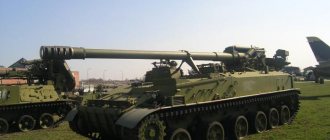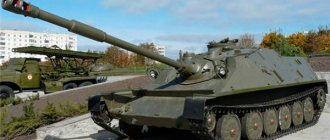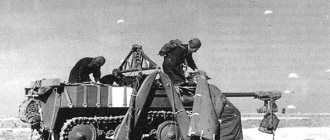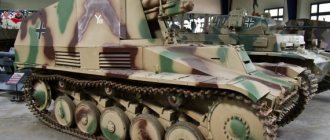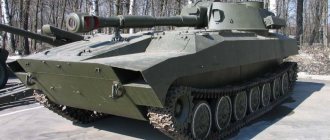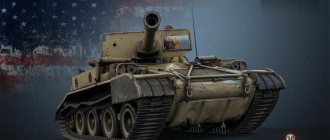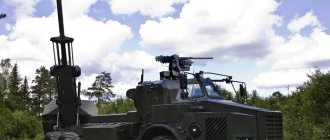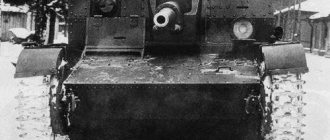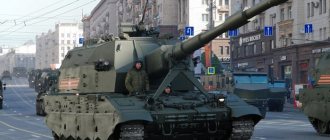The 203-mm self-propelled gun 2S7 (object 216) belongs to the reserve artillery weapon of the Supreme High Command. In the army it received the code name - self-propelled gun "Pion". The photos given in this article clearly demonstrate the full power of this weapon. It is intended to suppress nuclear weapons and other particularly important objects located in tactical depth (at a distance of up to 47 km).
History of creation
The creation of the Pion self-propelled gun began with a decision of the Council of Ministers of the Soviet Union in 1967. The assignment stated that the new weapon was supposed to destroy earthen, concrete and reinforced concrete fortifications, as well as destroy long-range enemy artillery installations. In addition, the Pion 2S7 self-propelled gun was designed as a “hunter” for tactical missile systems and other means of delivering nuclear charges. According to the assignment, the minimum destruction range was to be 25 km.
And now, two years later, from several proposed projects, the Council of Ministers chose the work of the designers of the Leningrad Kirov, created on the basis of the T-64 tank chassis with an open deckhouse design. However, in the same year, significant changes were made to the work on creating a new weapon. The reason was the presentation of Volgograd designers, who presented their project for an open self-propelled artillery mount based on object 429. As a result, the Ministry of Defense decides to combine these developments, and the 203-mm Pion self-propelled gun is transferred to a new chassis. This artillery mount had a firing range of up to 32 km with conventional ammunition and up to 42 km with active-reactive charges. Work on the creation of a long-range weapon was in full swing when, in March 1971, the GRAU approved updated requirements for the tactical and technical characteristics of the designed system. Engineers were asked to study the possibility of using a special shot from the ZVB2 of the B-4 howitzer with the same caliber. At the same time, the maximum firing range of conventional 110-kilogram shells was set at 35 km, and the minimum guaranteed ricochet-free range was 8.5 km. The longest firing distance with special active-reactive ammunition should have been 40-43 km. All these changes fell on the shoulders of the main developer of the self-propelled gun "Pion" 2S7 - KB No. 3 of the Kirov plant, whose head was N. S. Popov.
Main goals of self-propelled guns
The Pion artillery mount was originally designed for use in both global and local conflicts. The main emphasis was on countering the transportation of tactical nuclear weapons with their subsequent use.
The use of the Pion self-propelled gun is aimed at defeating the enemy in his tactical rear and on supply lines. Ammunition delivery vehicles, fortified facilities, communications centers, headquarters buildings, defensive positions - all of this is hit by artillery at a distance of up to 47 km.
Tactical and technical characteristics allow you to quickly transfer and deploy this artillery. This makes the Pion self-propelled gun in demand both in large battles and in local conflicts.
Creation of a weapon
At the same time, engineers under the leadership of chief designer G.I. Sergeev were developing the artillery part of the Pion self-propelled gun installation. The Volgograd team designed the warhead according to the classical design, but with a number of features. For example, a collapsible barrel became an interesting solution (a monoblock design is considered classic). It consisted of a breech, a connecting pipe, a coupling, a bushing and a casing. The author of this design is the engineer of the Obukhov plant A. A. Kolokoltsev, who developed it in the seventies of the century before last. The choice of this particular solution is explained by the fact that high-power artillery combat equipment (which is what “Peony” is) is subject to very rapid wear of the rifled part of the barrel when firing. As a result, monoblocks that have become unusable must be sent to the factory for replacement, which requires a significant investment of time. All this leads to the failure of this installation for a long time. Collapsible barrels are also subject to rapid wear, but the replacement process is quite feasible in the conditions of an artillery workshop located in the front-line zone; it does not require specific equipment and is relatively simple.
Agreements and settlements
Dry facts inform the modern reader that the development of a self-propelled gun began in 1967, by the spring of 1970 the technical specifications were finally formulated, and by the mid-70s the first copies of the new model began to arrive in units of the Soviet Army. However, the fairy tale soon takes its toll, and the work takes much longer to complete. The howitzer "Peony" was born in agony. The first life-size model, made of wood, was rejected by the leadership of the USSR Ministry of Defense and specialists of the Leningrad Artillery Academy. Then disputes arose over the caliber, because the gun was intended not only to fire special rounds, but also ordinary mass-produced defense shells. After long discussions, the customers settled on 203 millimeters, proposed by representatives as the optimal size. The choice of chassis was also not easy; the chassis of the T-10 and T-64 tanks were not suitable due to strong rollback. Ultimately, consensus was reached. The Kirov Plant, as the lead developer, was tasked with designing the Pion howitzer. The gun was entrusted to (Volgograd). Looking ahead, it can be noted that both enterprises successfully completed the government task.
"God of War with a Nuclear Gift"
This is exactly the nickname the new artillery mount received when it was presented by the designers of the Leningrad plant in 1975. The Ministry of Defense immediately appreciated the new self-propelled gun. And after a series of factory and field tests, the expert commission gave the go-ahead for its adoption and launch into mass production. In the same year, the first copies entered the troops. Artillery brigades of special power were equipped with new weapons, and they were intended to suppress and eliminate artillery, nuclear weapons, mortars, heavy equipment, logistics, enemy manpower, and command and control posts. Eight years later, in 1983, the Pion installation underwent its first modernization. The updated model received the code name “Malka”. The GRAU index remained the same, only with the addition: “M”-2S7M. It is safe to say that Soviet engineers were ahead of their time with their development, because almost 40 years have passed since the release of the first “Peony”, but this does not prevent it from remaining to this day the most powerful and sought-after artillery installation in the world. According to official data, more than 300 units of these weapons have been produced since 1975. After the collapse of the Soviet Union, many complexes ended up abroad, but continue to serve regularly in the armies of the countries of the former USSR. According to information from the Ministry of Defense, as of 2010, there were 130 units of Pion self-propelled guns in the Russian army. To understand what is unique about this artillery complex and why, despite the emergence of the latest types of long-range weapons, the modern weapons of the Russian army include these combat vehicles of a bygone era, let’s look at the technical characteristics of the installation.
Combat use of self-propelled guns
Despite the long period of operation in the USSR, the Pion self-propelled guns were not used in combat conditions. A large number of installations were part of the Group of Soviet Forces in Germany (GSVG), however, in 1990-91 they were all redeployed to the Siberian and Far Eastern military districts.
There is information about the use of 2S7 installations by the Georgian side during the war in South Ossetia in 2008. A battery of six self-propelled guns was deployed, but they were abandoned during the retreat. One such howitzer installation was taken by Russian troops as a trophy, the rest were destroyed.
This case is the only recorded combat use of the Pion artillery. There is information about the use of installations by Ukraine in the east of the country, however, they do not have documentary evidence. Currently, the 2S7 Pion self-propelled guns are in service with Angola, Azerbaijan, Georgia, Russia, Uzbekistan and Ukraine.
Description of the design of the artillery complex "Peony"
As mentioned above, the Pion self-propelled guns are designed with an open deckhouse, that is, according to a turretless design. The installation tool is located openly in the rear part of the tracked chassis. In the front part of the body there is a control compartment, then the engine and transmission compartment is located, followed by the crew compartment and the conning tower closes. The armored hull has a very unusual shape - the cockpit, placed far forward, serves as an additional counterweight to the heavy gun. The Pion artillery installation is maintained by a team of fourteen people, seven of whom are self-propelled gun crew. In the stowed position, the crew is located in the calculation and control compartments, and the remaining seven people are in a special truck or armored personnel carrier.
A powerful 203 mm caliber gun (2A44) is mounted in the rear part of the hull, the mass of which is 14.6 tons. In addition to the fact that the weapon is designed to be dismountable, it has an additional number of innovations. For example, the design refusal to use a muzzle brake provided a muzzle wave of low pressure in the crew's working area. This decision made it possible to abandon additional special protection for the servicing crew. The 203-mm gun is equipped with a piston bolt operating on a push-pull system. It opens and closes automatically thanks to a mechanical drive, and it is possible to perform this operation manually. In the Pion self-propelled gun, the supply and subsequent refueling of shells is carried out using a special chain loading mechanism that operates at any horizontal and vertical guidance angles. This design solution made it possible to significantly reduce the reload time, thereby increasing the rate of fire of the complex.
Ammunition used
Firing from the Pion artillery mount
The Pion artillery mount uses the following types of ammunition:
- high-explosive fragmentation ZOF43 and ZOF44;
- cassette Z-O-14;
- tactical nuclear weapon ZVB2.
The main armament of the 2S7 is high-explosive fragmentation shells, the rest are used according to the situation, depending on the task at hand.
Power unit and chassis of self-propelled guns
The most powerful self-propelled artillery unit in the world is equipped with a twelve-cylinder V-shaped diesel power unit B-46-1, equipped with a turbocharging system. Engine power is 750 hp. With. The use of this power unit allowed the 46-ton self-propelled gun to accelerate to a speed of 50 km/h. In addition, to ensure autonomous operation of the complex, an additional 24 hp diesel generator is installed in the engine and transmission compartment. With. In order to increase unification, a mechanical transmission with a bevel gearbox and onboard gearboxes was borrowed from the T-72. Thus, the self-propelled unit has a mechanical planetary power transmission with eight speeds and single-stage onboard reduction gearboxes.
The chassis has seven road wheels on both sides of the body with a torsion bar suspension equipped with individual locking hydraulic shock absorbers. Many chassis components are borrowed from the T-80. In fact, the chassis of the Pion self-propelled gun is a modernized version of the T-80 tank chassis; even the drive wheels are located at the front.
Performance characteristics of 2S7 Pion
— Years of production: 2С7 — from 1975 to 1985; 2S7M - from 1986 to 1990 - Years of operation: since 1975 - Number of produced, pcs: more than 500
Crew 2S7 Pion
— 7 people
Dimensions 2S7 Peony
— Hull length, mm: 10,500 — Length with gun forward, mm: 13,200 — Hull width, mm: 3380 — Height, mm: 3000 — Ground clearance, mm: 400
Ves 2S7 Peony
— 45 tons
Reservation 2S7 Pion
— Armor type: bulletproof — Hull forehead (bottom), mm/deg: 12 — Hull side, mm/deg: 8+13 — Bottom, mm: 8—16
Armament 2S7 Pion
— Caliber and brand of gun: 203 mm 2A44 — Gun type: rifled gun — Barrel length, calibers: 55.3 — Gun ammunition: 4 — Machine guns: 1 × 12.7 mm NSVT
Firing range of 2S7 Pion
— 8.4…47.5 km
Engine 2S7 Pion
— Engine type: V-46-1 — Engine power, l. s: 780 — Specific power, l. s./t: 17.25
Speed 2S7 Pion
— Highway speed, km/h: 50
— Cruising range on the highway, km: 675 — Fuel tank capacity, l: 1280.
Photo of self-propelled gun 2S7
Placement of units in the body of the self-propelled gun 2S7 "Pion"
SAU 2S7 Pion in combat position
Self-propelled gun 2S7 "Pion" from a firing position. The opener is lowered, the loading mechanism is in the working position. A shell is placed in the rammer tray, and a trolley for transporting shells stands nearby.
Support coulter SAU 2S7 Peony in stowed position
Similar
SAU 2S7 Pion (2S7M Malka) performance characteristics. Caliber. Dimensions. Firing range
MLRS BM-21 Grad. Damage area. Rockets. Caliber. Story
120-mm mortar 2B11 complex 2S12 Sani TTX. Firing range. Weight
Mortar 2B9M Vasilek 82 mm Rate of fire. Firing range. Weight
Self-propelled gun 2S3 Akatsiya 152 mm. Firing range. Dimensions. Weight. Engine
SAU 2S1 Gvozdika 122 mm Firing range. Dimensions. Device. Weight
Gun 2A36 Giatsint-B 152 mm. Firing range. Dimensions. Device
MLRS 9K58 Smerch Damage area. Rockets. Caliber. Story
MT-12 Rapier gun. Firing range. Story. Dimensions
Howitzer D-30 122-mm performance characteristics. Firing range. Dimensions. Weight
2S4 Tulip self-propelled mortar 240 mm performance characteristics. Dimensions. Firing range. Weight
Self-propelled gun 2S35 Koalitsiya-SV 152-mm performance characteristics. Firing range. Dimensions. Weight
Howitzer Msta-B (2A65) 152 mm. Firing range. Dimensions. Weight. Ammunition
Self-propelled gun 2S9 Nona-S 120 mm performance characteristics. Firing range. Dimensions. Weight. Armament
AT-T heavy artillery tractor. TTX. Dimensions. Engine. Story
SAU 2S19 Msta-S 152 mm Dimensions. Speed. Engine. Story
MLRS 9K57 Hurricane Damage area. Rockets. Caliber. Story
TOS-1 Buratino (TOS-1A Solntsepek) performance characteristics. Damage area
Divisional gun ZIS-3 76 mm. TTX. Firing range. Dimensions. Weight
Howitzer gun D-20 152 mm performance characteristics. Firing range. Dimensions. Weight
Howitzer M-30 model 1938 122-mm performance characteristics. Firing range. Dimensions. Weight
Self-propelled gun 2S5 Giatsint-S 152 mm performance characteristics. Firing range. Armament. Dimensions. Weight
Self-propelled gun Ferdinand (Elephant) performance characteristics. Reservation. Weight. Dimensions
Self-propelled gun SU-100. TTX. Armament. Dimensions. Shells. Weight. Speed
Self-propelled gun Sturmtiger caliber 380 mm. TTX. Armament. Shells. Reservation. Dimensions
203-mm howitzer B-4 model 1931 performance characteristics. Weight. Ammunition. Dimensions
Self-propelled gun SU-152 St. John's wort 152 mm performance characteristics. Shells. Firing range. Dimensions. Weight
Gun M-46 130-mm performance characteristics. Firing range. Dimensions. Weight
Demining installation UR-77 Meteorite TTX. Armament. Dimensions
MLRS 9K51M Tornado-G. Rockets. TTX. Firing range. Dimensions
SAU 2S31 Vienna 120 mm. Firing range. Story. Dimensions. Weight
German self-propelled gun StuG III. Modifications. Dimensions. Armament. Weight
Guided projectile Krasnopol. TTX. Firing range. Dimensions. Price
Mortar Karl 600 mm and 540 mm performance characteristics. Firing range. Weight. Dimensions
Big Bertha 420 mm gun. TTX. Weight. Dimensions. Ammunition
Self-propelled gun SU-76. TTX. Dimensions. Reservation. Weight. Story
SAU 2S23 Nona-SVK 120-mm performance characteristics. Armament. Range and accuracy of fire. Dimensions
SAU 2A3 Condenser-2P caliber 406 mm Firing range. Armament. Dimensions. Weight
Mortar M-160 caliber 160-mm performance characteristics. Firing range. Ammunition. Dimensions
Airborne self-propelled gun ASU-57. Armament. TTX. Dimensions. Weight. Booking
Artillery complex A-222 Bereg 130 mm. TTX. Firing range. Ammunition
Howitzer BR-18 caliber 305 mm TTX. Firing range. Weight
152 mm howitzer D-1. Firing range. Dimensions. Weight. Device
Mortar M-240 caliber 240 mm. Firing range. Dimensions. Weight
Self-propelled gun SU-85. Ammunition. Reservation. Dimensions. Weight. Engine
Counter-battery radar Zoo-1 (1L219M). Range of control of firing positions. Device
SAU 2S25 Sprut-SD. Caliber. Story. Dimensions. Weight. Engine
Self-propelled gun 2S34 Hosta 120 mm. TTX. Dimensions. Firing range. Armament. Weight
Self-propelled gun ASU-85. Armament. Dimensions. Reservation. Weight
280-mm mortar Br-5 model 1939 Dimensions. Weight. Ammunition
Self-propelled gun 2A45M Sprut-B. TTX. Speed. Engine. Weight
Belarusian MLRS BelGrad. TTX. Firing range. Ammunition. Dimensions
S-23 cannon 180 mm caliber. Ammunition. Weight. Dimensions. Firing range
Self-propelled gun SAU SU-122. Dimensions. Armament. Reservation. Weight
Self-propelled gun Jagdpanther. Weight. Reservation. Dimensions. Armament
Multi-barreled self-propelled gun M50 Ontos. TTX. Armament. Dimensions. Booking
D-74 cannon 122 mm caliber. Firing range. Dimensions. Weight
Artillery tractor T-20 Komsomolets. Armament. Reservation. Dimensions. Weight
Artillery tractor YA-12. Dimensions. Weight. Load capacity. Engine
SAU ISU-122. Armament. Dimensions. Weight. Booking
RPU-14 (8U38) - rocket launcher
2K32 Deva - 82-mm self-propelled mortar system
MLRS BM-24 (T) 240 mm. Firing range. Dimensions. Weight. Engine
Artillery tractor Comintern. Load capacity. Dimensions. Weight. Engine
Self-propelled gun SU-122-54. Reservation. Dimensions. Weight. Firing range
MLRS BM-14-16. Armament. Dimensions. Weight. Firing range
Self-propelled gun Nashorn (Rhinoceros). Armament. Dimensions. Weight. Booking
BR-2 gun caliber 152 mm. Firing range. Dimensions. Weight
Self-propelled howitzer self-propelled gun PzH 2000. Firing range. Dimensions. Weight
BR-17 cannon 210 mm caliber. Weight. Firing range. Rate of fire
Self-propelled gun Vespe 105 mm. Armament. Dimensions. Reservation. Weight
Wheeled self-propelled gun GAZ-68 (KSP-76). Armament. Dimensions. Weight. Engine
Self-propelled gun Brummbar 150 mm. Armament. Dimensions. Weight. Booking
Heavy self-propelled gun SU-14. Reservation. Dimensions. Weight. Engine
Self-propelled gun SU-5. Armament. Reservation. Dimensions. Weight
Self-propelled gun AT-1. Reservation. Dimensions. Weight. Engine
Self-propelled gun SU-12. Armament. Reservation. Dimensions. Weight
Firing
Loading operations for the gun are carried out from a special remote control; the shells are supplied using a standard single-axle hand truck. When aiming the gun, mechanical and electro-hydraulic drives are used. The rate of fire of the Pion artillery complex is one and a half rounds per minute. The installation provides the following firing modes: 8 shots in 5 minutes; 15 shots in 10 minutes; 24 shots in 20 minutes; 30 shots in 30 minutes and 40 shots in an hour. There are hydropneumatic recoil mechanisms on the barrel in its upper and lower parts. The recoil length of the gun is approximately 1400 mm. Considering the enormous power of the installation, the engineers provided special guides that are located in the rear of the body. They are installed immediately before firing on the ground and play the role of auxiliary supports. In addition, to absorb the very noticeable recoil force, a bulldozer-type coulter is installed in the rear part of the body. It is controlled using a hydraulic drive. During firing, the coulter goes deep into the soil to a depth of 700 mm, thereby providing the self-propelled unit with excellent stability. In addition, to absorb the rollback force, the designers provided a locking system for the hydraulic shock absorber suspension units of the main rollers of the tracked chassis, as well as lowering guide wheels.
Thanks to the use of very effective recoil mechanisms, firing from the gun can be carried out over a wide range of aiming angles. Thus, the horizontal convergence angle is 30 degrees, and in the vertical plane - in the range from 0 to 60 degrees.
In the case when firing occurs from the ground, the crew can use a two-wheeled trolley, on which charges and shells are placed on a special removable stretcher. The ammunition of the Pion artillery mount is 40 separate-loading shells. Four of them are stored in the aft compartment and provide an emergency reserve, while the rest are transported on special vehicles and laid out on the ground when preparing the self-propelled gun for firing.
How to charge
The standard ammunition of this weapon is quite heavy, it can weigh up to 110 kg. Therefore, the 2S7 “Pion” self-propelled howitzer is equipped with a mechanical device with a manipulator and remote control. The projectile can be lifted from the ground or a truck; the pointing angle does not need to be changed. The aiming is thus not lost. In emergency cases, special stretchers or a standard trolley are also used.
Of particular note is the maximum degree of duplication of control mechanisms. In the event of failure or failure of the electrical system, hydraulics or pneumatics, any operation can be performed by mechanical means, simply by rotating the corresponding handle. It will be slower, but completing the combat mission is still possible.
A charge equipped with a fuse and intended to impart initial velocity to the projectile is placed in the breech in fabric bags stored in special waterproofed boxes. For such powerful guns, only the cap loading method is applicable.
Armament
The range of ammunition for the "Peony" is very diverse: 203-mm shells ZVOF42 and ZVOF43, fragmentation shells 30F43, active-reactive high-explosive fragmentation shells ZOF44, ZVOF15 and ZVOF16 with fragmentation charges with 3-0-14 submunitions. The Pion military equipment is equipped with a mechanical sight of the D-726 type, a K-1 collimator, and a PG-1M panorama. In addition, there is an additional sighting device of the OP-4M type, used for direct fire. To protect the self-propelled guns and people, the installation is also equipped with personal weapons for the crew: this includes small arms (four machine guns and a signal pistol), and RPG-7 hand-held anti-tank grenade launchers, Strela-2 MANPADS, as well as F-1 grenades.
"Malka"
Over fifteen years of military operation, the shortcomings of the Pion howitzer were identified. The range and accuracy characteristics of the military were quite satisfactory; the bottleneck turned out to be some driving and operational indicators. In addition, the loading time and the related and inversely related rate of fire also left much to be desired. By 1980, artillerymen were no longer satisfied with the information capabilities of on-board equipment.
The modified self-propelled howitzer "Pion" received the index "M" and the code name "Malka". It differed from the prototype in a more powerful all-fuel engine (gasoline, kerosene and, in general, almost anything that burns are suitable for it), new fire control equipment (having a high degree of automation), an improved ammunition stowage system for ammunition (now there are eight of them, twice as many as originally carried the howitzer "Peony"). The chassis has also undergone modernization, as a result of which the engine life has increased to 10 thousand km. The ACS systems received an indication of performance monitoring.
The most important improvement concerned the rate of fire. The remote mechanism has been redesigned, resulting in an increase in loading speed by 60% (up to 1 shot in 24 seconds). The danger of retaliatory damage to the gun prompted the designers to provide an option for remote control with digital display of all firing processes from the command vehicle, in which signals are transmitted via radio channels or wired communications.
Nuclear weapons and defense
The Pion artillery self-propelled gun is capable of taking part in armed conflicts using nuclear weapons. For this purpose, the self-propelled gun has a filter-ventilation unit, an automatic fire-fighting system, and a sealing system for habitable compartments, capable of protecting the crew and crew from nuclear, bacteriological and chemical weapons. In addition, it is equipped with equipment for internal telephone communication, a radio station and a night vision device. To deliver an atomic strike to an enemy, the Pion self-propelled gun can use special ammunition with a nuclear charge. The use of such shells is possible only if there is a corresponding order from higher command. In this case, ammunition is delivered to the firing position from special storage facilities as part of a guarded convoy. The nuclear projectile is designed to destroy particularly large infrastructure facilities, industrial facilities, concentrations of enemy troops, etc. The minimum firing range of such ammunition is 18 km, and the maximum is 30 km.
Advantages and disadvantages
Compared to domestic and foreign analogues, the Pion self-propelled gun has the following advantages:
- long firing range, which excludes counter-battery fire;
- excellent mobility in deployment and collapse - the installation can leave the position even before the projectile fired at maximum range reaches the target;
- good maneuverability and speed - allow you to transfer artillery depending on the situation.
There are also design advantages. Excavator bipods can burrow into the ground up to 800 mm, improving the stability of the installation. The gun barrel is noted to be disassembled, which makes it possible to change its quickly wearing parts in front-line workshops.
One of the disadvantages is the small azimuth pointing angle, taking into account the strong recoil of the gun. They also note the need to move the vehicle if the firing angle exceeds 30 degrees.
Self-propelled artillery mount 2S7M "Malka"
In 1983, Design Bureau No. 3 of the Kirov Plant modernized the Pion installation. As a result, the updated model began to differ from its predecessor in rubber-coated chassis elements; in addition, the chassis began to be made of more high-strength materials. The complex's control system has new firing equipment capable of receiving information automatically. In addition, engineers improved the remote loading mechanism and changed the design of the charging packs. New charges and ammunition of increased power were introduced, and the emergency supply of shells was increased to eight units. The updated ammunition included active-missile projectiles. In addition, a system of regulated monitoring of continuous operation with an automatic diagnostic system for the state of all key subsystems of the artillery installation was installed on the Malka self-propelled guns.
Improvements to the chassis made it possible to increase the service life of the motorcycle race to ten thousand kilometers. Thanks to the modernization of the installation's remote loading device, this procedure has become possible at any vertical aiming angle. In addition, the rate of fire of the complex increased significantly (1.6 times) - up to 2.5 rounds per minute, and the continuous firing time was three hours. The fire control option with automatic data reception made it possible to receive target coordinates through wired and radio communications with their subsequent display on digital indicators of the gunner's and commander's instruments, while the guidance system independently takes into account changes in weather conditions. The updated ammunition included active rockets with a firing range of 55 km, as well as high-precision and anti-tank ammunition with ramjet engines.
Today, the self-propelled guns “Pion” and “Malka” have enormous potential for further modernization; they are able to keep up with the times and use modern weapons in their arsenal, including tactical and high-precision weapons.
Tactical task
During a large-scale strategic offensive operation, according to military theorists and commanders, in its first phase it is necessary to suppress pockets of resistance, plunge the enemy’s communication and control systems into chaos, thereby causing the greatest damage to its defense capabilities. To accomplish this task, tactical missiles, bomber and attack aircraft, and other means of fire, including long-range artillery, are used in our time. The advantage of the latter is the relative cheapness of each shot (compared to missiles) and the difficulty of hitting a projectile with an atomic charge in flight. The weapon must have a number of technical indicators, among which the main ones are: firing range (at least 25 km, otherwise friendly troops will end up in a cloud of radiological contamination), sufficient mass of the thrown charge (about a hundredweight) and fairly high accuracy. The 2S7 Pion howitzer meets these requirements; moreover, it is still considered the most powerful artillery system in the world.
St. Petersburg: artillery museum
This institution was founded in 1703 by decree of Peter the Great as a Zeichhaus - a storage place for curious and memorable artillery pieces. The most valuable and interesting specimens were brought here from all over the country. Later, other types of weapons, banners, and uniforms, including captured ones, began to be added to the exhibition. Later, during the time of Elizabeth Petrovna, this artillery museum was renamed the Memorable Hall, and it was located at the Liteiny Dvor. And only in 1869 this establishment began to actively live and develop. This year, the Artillery Museum receives part of the Kronverk building at its disposal; military-historical collections are housed here. During the Soviet Union, in 1963, the institution received the funds of the Central Historical Military Engineering Museum, and two years later it included the Military Museum of Communications.
Visitors are invited to get acquainted with the rarest collections of world weapons from 55 countries, from the fourteenth century to the present day. Here you can see among the exhibits personal weapons of members of the imperial family, outstanding commanders, unique documents, military awards, military uniforms, models of fortifications and fortresses and much more. A separate exhibition presents Russian artillery, including experimental samples of guns by Shuvalov, Nartov and others.
The Military Historical Museum of Artillery, Engineering Troops and Signal Corps has one of the largest collections of weapons from Western European countries of the 15th-17th centuries in our country. In 2006, the institution opened a new exhibition dedicated to the history of military affairs of the Middle Ages, Renaissance, and early modern times. Both adults and children enjoy visiting the Artillery Museum; here, in the courtyard of Kronverk, modern types of weapons of the Russian army are presented, such as the intercontinental strategic missile system of the Topol RS-12M mobile ground-based missile system and many others. Guests can not only look at them, but also touch them with their hands, take pictures next to such giants, which serve as a guarantor of the security of our country from external invasion. After all, most schoolchildren have a superficial familiarity with such types of weapons as self-propelled guns, tanks, armored personnel carriers, artillery pieces, which they receive from computer games and television films. Having seen them with their own eyes, having felt the power of their armor and guns, they will forever be filled with respect not only for the military profession, but also for the designers who created these wonderful machines. Children and adults will be interested in visiting both festivals of military-historical reconstruction and demonstration performances by members of the Silhouette Historical Fencing Club, which are regularly held on the territory of the museum. So, an unforgettable experience for museum visitors is guaranteed!
Historical background
The first Soviet atomic charge was successfully tested in 1949. But it is not enough to possess weapons of mass destruction; delivery means are needed to use them. At that time, the only way to deliver a nuclear strike was aerial bombardment, and the Stalinist USSR had at its disposal only one type of aircraft capable of carrying a multi-ton terrible burden over a fairly long distance. The Tu-4 was copied from the American B-29, which had previously “distinguished itself” with strikes on Hiroshima and Nagasaki. But Soviet artillery systems were considered unsurpassed, and one of the first was the idea of using them to fire low-power atomic bombs. Later, more than two decades later, the Pion howitzer became the real embodiment of this design idea, and then, in the early fifties, they tried to implement it, but not very successfully. Tests of the 2A3 self-propelled gun and the 2B1 heavy mortar revealed a number of fundamental defects of these systems, mainly due to their bulkiness and heavy weight. During the reign of N.S. Khrushchev, artillery was generally no longer considered a modern type of weapon. As it turned out, it was premature.
Here and abroad
After the collapse of the Soviet Union, the Pion self-propelled howitzer found itself, for various reasons, in service with the armies of a dozen countries. Among them, first of all, the legal successor of the USSR is the Russian Federation, which has 320 units, most of which are mothballed, Uzbekistan (48 units), Belarus (36), Azerbaijan and Angola (12 each), Poland (there are eight 2S7 units here). Pion", sold in 1989 by the Soviet Union, has already been withdrawn from service) and several other states. The weapon for regional conflicts most often appears to be excessively powerful. This determines the limited conditions for its use. In a combat situation, there has been only one case so far in which the Pion howitzer was used, and very unsuccessfully. A photo of a self-propelled gun captured from the Georgian army was published in August 2008 by almost all the world's media. Five self-propelled guns were supplied by Ukraine, four of them were destroyed, one was included in the list of trophies of the Russian Army.
There is only a small list of situations in which the Pion howitzer can be justifiably used. The characteristics of this weapon are such that it is of little use for combating point targets. This combat weapon was created to deliver tactical nuclear weapons. When using special charges, the spread relative to the target, measured in tens of meters, does not matter much. Therefore, military specialists should take into account the capabilities and characteristics of the Pion howitzer. In Ukraine, about a hundred guns of this type remained after the collapse of the USSR. For 23 years they stood quietly in warehouses covered in grease. The conflict in the South-East prompted the country's leadership to order the reactivation of several units and bringing them into combat-ready condition. Will the Pion howitzer fire? Photos of heavy installations loaded onto railway platforms, in theory, should inspire the idea of an imminent victory... But we sincerely hope that it will not come to their use.
